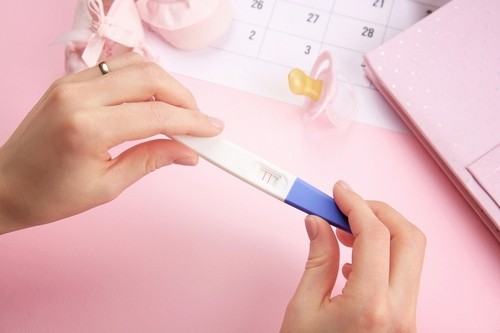For testing, special antibodies to hCG are used. As soon as they come into contact with the hormone, they change their color. Due to this, the test can report that hCG is present in the urine.
Pregnancy testing at home is popular with many women waiting to be added to the family. Of course, there are laboratory methods for checking pregnancy, but all of them require much more time and effort. In most cases, urine is used for testing. What biological principles is this test based on?
Many biologically active substances produced by the body enter the urine. These include human chorionic gonadotropin (hCG). This is a hormone that begins to be produced in the female body as soon as a fertilized egg attaches to the surface of the outer layer of the uterine wall – the endometrium, and begins its development.
Therefore, by the presence of hCG, it can be determined whether the embryo began to develop or not. In the first days of pregnancy, the hormone level increases exponentially. And already after 7-10 days, the hormone can be detected in the urine in quantities available for measurement.
Of course, hCG is found not only in the urine, but also in the blood of a woman. However, blood sampling for analysis is not so convenient. Therefore, urine is used in all home tests.
Home tests for hCG are able to give only a qualitative result. That is, they give an answer to only one question: is there a hormone in the body or not? A quantitative analysis to determine the exact amount of hCG can only be done with blood, not urine. Knowing the exact amount of the hormone, you can calculate the duration of pregnancy, since the concentration of the hormone is a function of time. However, such an analysis cannot be carried out at home.

Another important point to keep in mind. A urinalysis indicates only that it contains hCG, and not about the pregnancy itself. Meanwhile, sometimes the presence of a hormone in the urine can also occur when pregnancy is absent. This situation is extremely rare, but still it cannot be ruled out. For example, this can happen if a woman takes hCG drugs, or hCG is produced by a tumor inside the body.
Therefore, a home pregnancy test is only the first step in the process of diagnosing pregnancy. He does not exclude subsequent visits to the gynecologist and a pregnancy check with laboratory tests and ultrasound. The likelihood of an ectopic pregnancy, which cannot end in the birth of a child, cannot be ruled out. A rapid test with urine is not able to determine this condition. After all, even if the egg did not attach to the endometrium, but remained in the fallopian tube, hCG will still be produced.
If the pregnancy is finally confirmed, then the life of the future mother will be different. After all, during pregnancy, she will have to change her lifestyle, endure a lot and suffer. And the beginning of these changes was laid by a small strip of paper – a pregnancy test. Many women even preserve it, as a memory of an unforgettable moment of joy.
Test Methodology
The technique may vary slightly for different types of tests, but in general has common features. For testing, it is advisable to take morning urine collected immediately after waking up. This urine is the most concentrated. Reception on the eve of testing any food, alcohol, smoking does not affect the results. Although with a planned pregnancy, drinking alcohol and smoking is, of course, not recommended. However, you can not drink a lot of water, since a large amount of liquid dilutes the urine.
Urine is collected in a container, and then a test strip is lowered for 10-12 seconds. It is important not to hold the strip for too long, but insufficient exposure can also distort the result. This technique is true only for test strips (strip tests). In cassette tests, the cassette does not need to be lowered anywhere. It is necessary to collect the liquid in a pipette and drop it into a special window on the cassette. And in jet tests, urine can not even be collected in any dishes. It is enough to substitute a test strip under the stream of urine.
After the urine has been applied to a strip or cassette, you need to put it on a flat surface and wait. How long to wait is indicated in the instructions, but, as a rule, no more than 15 minutes. After the required time, the result will be clear. If one transverse dark line appears on the strip – the test is negative (no pregnancy), two dark lines – the test is positive. The absence of lines means that the test was carried out incorrectly (insufficient urine or exposure time) or indicates that the strip was initially unusable (for example, expired). In cassettes, the result will appear in a special window. In electronic devices for testing, the results can be displayed in the form of text messages.
It is necessary to remember some nuances. Since the test is high-quality, it does not matter how intense the color of the second line will be. Only the fact of its presence is important. However, if some semblance of a white line appeared on the strip, this only speaks of the evaporation of urine from the surface of the strip, and not the presence of hCG.
If the test showed a negative result, then you should not be upset ahead of time. Perhaps just a strip is not sensitive enough. Or the rules of the test were violated, for example, a woman drank too much water the day before. Therefore, the test can be repeated a few days later to be 100% sure. The test can also be carried out if the second feature is too weak, and there are doubts about the correct interpretation of the results. However, in some diseases, for example, with renal failure, the level of hCG can also be low, and the test will show a false negative result.
In order not to do additional tests with urine, it is better to immediately buy tests with high sensitivity. For each test, its sensitivity is indicated in international units.
There are four classes of sensitivity:
- 10,
- twenty,
- 25,
- thirty.
The most sensitive are strips with an index of 10.
It is also important to choose the right time for testing. The optimal time is the first days of delayed menstruation. The most sensitive tests allow you to determine pregnancy at 7-10 days after the egg is attached to the endometrium. That is, theoretically, pregnancy can be recognized even before the onset of menstruation. However, ovulation can often be delayed for several days. As a result, a test performed before menstruation may not show anything.
Stages of testing with urine (for test strips):
- Collect urine in a container
- Lower the strip into the urine for 5-15 seconds,
- Pull a strip from the urine and place it on a flat surface,
- Wait 1-15 minutes
- Read the result (1 cross dark line – negative, 2 cross dark lines – positive).
Alternative pregnancy testing methods
On various sites you can read about various ways to find out about pregnancy without using pharmacy tests. In some of them, it is proposed to use baking soda as a reagent that comes into contact with urine, in others – iodine or potassium permanganate, and sometimes it is simply suggested to boil urine. And by the type of chemical reaction or by a change in the color and consistency of urine, it is proposed to determine whether a woman whose urine was used or not is pregnant.
It should be immediately said that all these methods not only have no scientific justification, they are simply meaningless from a logical point of view. After all, even a general urinalysis is not able to answer the question of whether a woman is pregnant. If this were not so, then it would be enough to just do such an analysis. However, the urine of a woman in early pregnancy does not undergo significant changes compared to the previous period. The only change is the presence of hCG, but this substance does not react with either soda or iodine.
Of course, there are reviews of women to whom such an “analysis” of urine helped, but these facts are easily explained by a simple coincidence. And the state of pregnancy is too serious a thing to try to determine its presence, doing divination on coffee grounds. Better to trust proven methods. By the way, the accuracy of the means for checking pregnancy, sold in pharmacies, even the cheapest, approaches 99% (although in terms of sensitivity and ease of use, they can differ significantly from each other).



